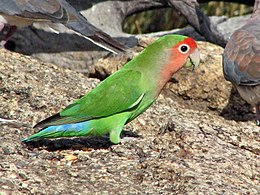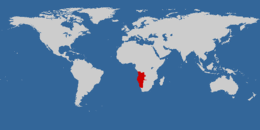Rosy-faced lovebird
| Rosy-faced lovebird | |
|---|---|
 |
|
| In Namibia, Africa | |
| Scientific classification | |
| Kingdom: | Animalia |
| Phylum: | Chordata |
| Class: | Aves |
| Order: | Psittaciformes |
| Family: | Psittaculidae |
| Genus: | Agapornis |
| Species: | A. roseicollis |
| Binomial name | |
|
Agapornis roseicollis (Vieillot, 1818) |
|
 |
|
| Native ranges in the Namib Desert and arid areas of Namibia and Angola | |
The rosy-faced lovebird (Agapornis roseicollis), also known as the rosy-collared or peach-faced lovebird, is a species of lovebird native to arid regions in southwestern Africa such as the Namib Desert. A loud and constant chirper, these birds are very social animals and often congregate in small groups in the wild. They eat throughout the day and take frequent baths. Coloration can vary widely among populations. Plumage is identical in males and females. Lovebirds are renowned for their sleep position in which they sit side-by-side and turn their faces in towards each other. Also, females are well noted to tear raw materials into long strips, "twisty-tie" them onto their backs, and fly substantial distances back to make a nest. They are common in the pet industry, although lovebirds are often not hand-raised.
It was described by the French ornithologist Louis Jean Pierre Vieillot in 1818. It was originally named Psittacus roseicollis but later moved to the genus Agapornis with the other lovebirds.
Two subspecies are recognised:
The rosy-faced lovebird is a fairly small bird, 17–18 cm long with an average wing length of 106 mm and tail length of 44–52 mm. Wild birds are mostly green with a blue rump. The face and throat are pink, darkest on the forehead and above the eye. The bill is horn coloured, the iris is brown and the legs and feet are grey. The pink of the A. r. roseicollis is lighter than of the A. r. catumbella. Juvenile birds have a pale pink face and throat, a greenish fore crown and crown, and the beak has a brownish base.
It inhabits dry, open country in southwest Africa. Its range extends from southwest Angola across most of Namibia to the lower Orange River valley in northwest South Africa. It lives up to 1,600 metres above sea-level in broad-leaved woodland, semi-desert, and mountainous areas. It is dependent on the presence of water sources and gathers around pools to drink.
Escapes from captivity are frequent in many parts of the world and feral birds dwell in metropolitan Phoenix, Arizona, where they live in a variety of habitats, both urban and rural. Some dwell in cacti and others have been known to frequent feeders in decent sized flocks.
Populations have been reduced in some areas by trapping for the pet trade. However, numbers may have increased in other areas due to human creation of new water sources and the building of artificial structures which provide new nesting sites. Because of this, the species is classed as Least Concern by the International Union for Conservation of Nature (IUCN).
...
Wikipedia

